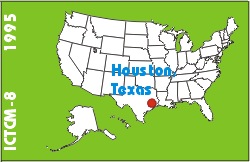
Electronic Proceedings of the Eighth Annual International Conference on Technology in Collegiate MathematicsHouston, Texas, November 16-19, 1995Paper C031A Cupful of Limacons |
Michael L. TreudenDepartment of Mathematics and Computing University of Wisconsin-Stevens Point Stevens Point, WI 54481-3897 USA Phone: (715) 346-4607 m1treude@uwspmail.uwsp.edu |
| Click to access this paper: |
Additional file(s) associated with this paper:
|
ABSTRACT
Have you ever examined the light patterns on the bottom of a cup or bowl with reflective sides and wondered what shapes you see? If a light source is placed somewhat off center, rather than directly above, you might conjecture that the pattern resembles a cardioid. The purpose of this paper is to discuss how students may furnish some answers by using elementary vector algebra and orthogonal projections with the aid of a computer algebra system (CAS). For instance, if the cup is a simple right circular cylinder, then it will become readily apparent that the image is generated by infinitely many limacons.We suppose the unit disk x^2+y^2<=1 is the bottom of the cup and the sides are formed by revolving the graph of a smooth function x=f(z) with f(0)=1 and f'(z)>=0 about the z-axis. For example, f(z)=1 when the cup is a cylinder. A CAS such as Mathematica, for example, makes it easy to model the reflected light rays formally, without even specifying exactly what f(z) is. By then making particular choices for f(z), we may use the plotting capabilities a CAS provides to assess the accuracy of the model by comparing the graphs with what is seen in reality.
Keyword(s): computer algebra systems, Mathematica, geometry
